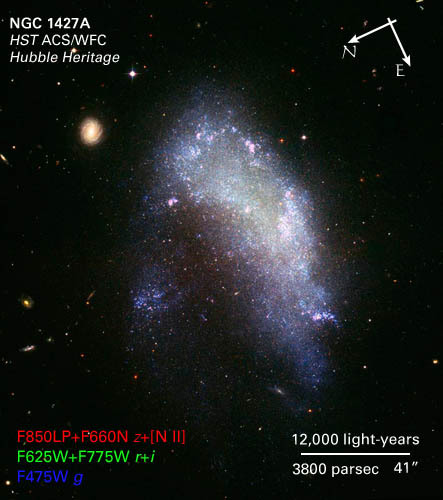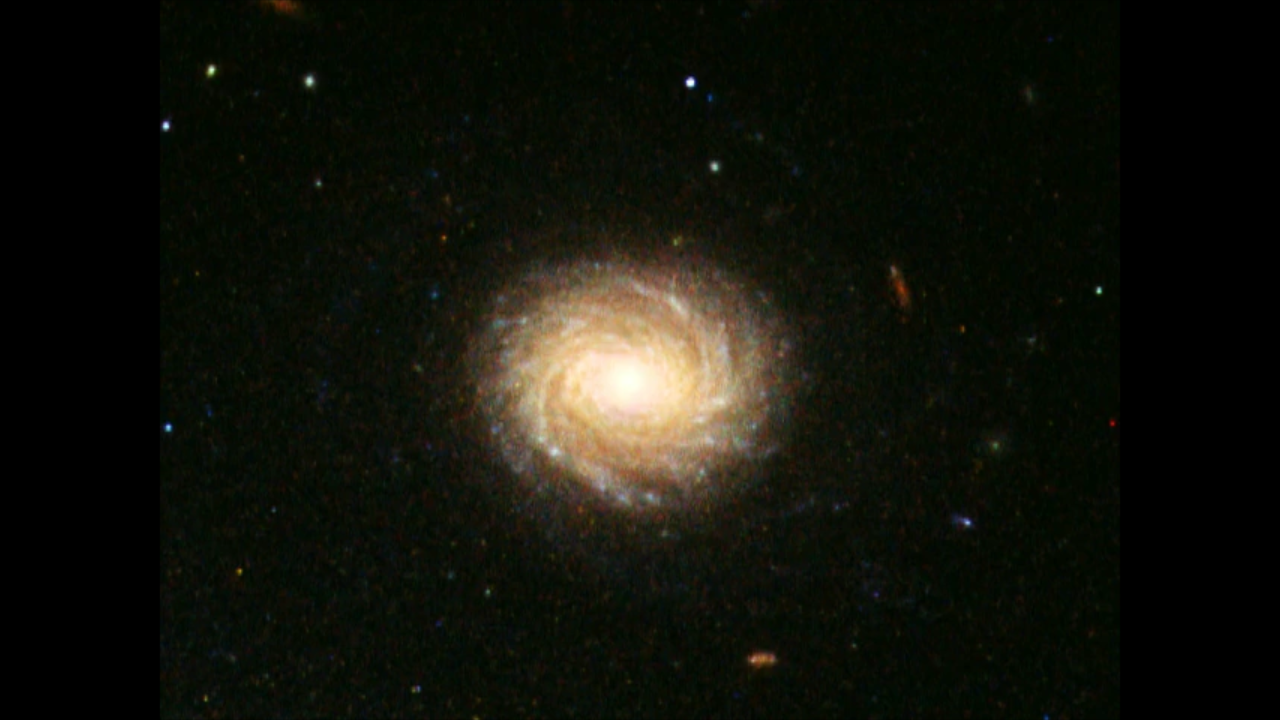1 min read
Galaxy NGC 1427A Plunges Toward the Fornax Galaxy Cluster

What happens when a galaxy falls in with the wrong crowd? The irregular galaxy NGC 1427A is a spectacular example of the resulting stellar rumble. Under the gravitational grasp of a large gang of galaxies, called the Fornax cluster, the small bluish galaxy is plunging headlong into the group at 600 kilometers per second or nearly 400 miles per second.
NGC 1427A, which is located some 62 million light-years away from Earth in the direction of the constellation Fornax, shows numerous hot, blue stars in this newly released image obtained by the Hubble Space Telescope. These blue stars have been formed very recently, showing that star formation is occurring extensively throughout the galaxy.
Galaxy clusters, like the Fornax cluster, contain hundreds or even thousands of individual galaxies. Within the Fornax cluster, there is a considerable amount of gas lying between the galaxies. When the gas within NGC 1427A collides with the Fornax gas, it is compressed to the point that it starts to collapse under its own gravity. This leads to formation of the myriad of new stars seen across NGC 1427A, which give the galaxy an overall arrowhead shape that appears to point in the direction of the galaxy's high-velocity motion. The tidal forces of nearby galaxies in the cluster may also play a role in triggering star formation on such a massive scale.
NGC 1427A will not survive long as an identifiable galaxy passing through the cluster. Within the next billion years, it will be completely disrupted, spilling its stars and remaining gas into intergalactic space within the Fornax cluster.
To the upper left of NGC 1427A is a background galaxy that happens to lie near Hubble's line of sight but is some 25 times further away. In contrast to the irregularly shaped NGC 1427A, the background galaxy is a magnificent spiral, somewhat similar to our own Milky Way. Stars are forming in its symmetric pinwheel-shaped spiral arms, which can be traced into the galaxy's bright nucleus. This galaxy is, however, less dominated by very young stars than NGC 1427A, giving it an overall yellower color. At even greater distances background galaxies of various shapes and colors are scattered across the Hubble image.
The Hubble Space Telescope's Advanced Camera for Surveys was used to obtain images of NGC 1427A in visible (green), red, and infrared filters in January 2003. These images were then combined by the Hubble Heritage team to create the color rendition shown here. Astronomers are using the data to investigate the star-formation patterns throughout the object, to verify a prediction that there should be a relation between the ages of stars and their positions within the galaxy. This will help them understand how the gravitational influence of the cluster has affected the internal workings of this galaxy, and how this galaxy has responded to passing through the cluster environment.
The disruption of objects like NGC 1427A, and even larger galaxies like our own Milky Way, is an integral part of the formation and evolution of galaxy clusters. Such events are believed to have been very common during the early evolution of the universe, but the rate of galaxy destruction is tapering off at the present time. Thus the impending destruction of NGC 1427A provides a glimpse of an early and much more chaotic time in our universe.
About the Object
- R.A. PositionR.A. PositionRight ascension – analogous to longitude – is one component of an object's position.03h 40m 8.99s
- Dec. PositionDec. PositionDeclination – analogous to latitude – is one component of an object's position.-35° 37' 33.99"
- ConstellationConstellationOne of 88 recognized regions of the celestial sphere in which the object appears.Fornax
- DistanceDistanceThe physical distance from Earth to the astronomical object. Distances within our solar system are usually measured in Astronomical Units (AU). Distances between stars are usually measured in light-years. Interstellar distances can also be measured in parsecs.The galaxy is roughly 62 million light-years (19 Megaparsecs) away.
- DimensionsDimensionsThe physical size of the object or the apparent angle it subtends on the sky.This image is 2.8 arcminutes (51,000 light-years or 16,000 parsecs) wide.
About the Data
- Data DescriptionData DescriptionProposal: A description of the observations, their scientific justification, and the links to the data available in the science archive.
Science Team: The astronomers who planned the observations and analyzed the data. "PI" refers to the Principal Investigator.These data are from the HST program 9689: M. Gregg (Univ. Calif - Davis and Inst. for Geophysics and Planetary Physics and Lawrence Livermore Natl. Lab.), M. Drinkwater (Univ. Queensland, Australia), and B. Holden (Univ. Calif.- Davis). Other collaborators include M. Hilker (Astronomical Institutes of Bonn Univ.) and J. Chaname (Ohio State Univ.). - InstrumentInstrumentThe science instrument used to produce the data.HST>ACS/WFC
- Exposure DatesExposure DatesThe date(s) that the telescope made its observations and the total exposure time.January 9, 2003, Exposure Time: 2.4 hours
- FiltersFiltersThe camera filters that were used in the science observations.F475W (SDSS g), F625W (SDSS r), F660N ([N II]), F775W (SDSS i), F850LP (SDSS z)
- Object NameObject NameA name or catalog number that astronomers use to identify an astronomical object.NGC 1427A
- Object DescriptionObject DescriptionThe type of astronomical object.Dwarf Irregular Galaxy
- Release DateMarch 3, 2005
- Science ReleaseThe Impending Destruction of NGC 1427A
- CreditNASA, ESA, and The Hubble Heritage Team (STScI/AURA); Acknowledgment: M. Gregg (Univ. Calif.-Davis and Inst. for Geophysics and Planetary Physics, Lawrence Livermore Natl. Lab.)

Blue: F475W (SDSS g) Green: F625W (SDSS r) + F775W (SDSS i) Red: F660N ([N II]) + F850LP (SDSS z)

Related Images & Videos

A Grand-Slam of Stars in NGC 1427A
The Hubble Space Telescope's Advanced Camera for Surveys was used to obtain images of irregular galaxy NGC 1427A. A pullout from a neighbor galaxy to NGC 1427A reveals the fine details captured by Hubble of numerous hot, blue stars that have been formed very recently, showing...
Share
Details
Claire Andreoli
NASA’s Goddard Space Flight Center
Greenbelt, Maryland
claire.andreoli@nasa.gov































